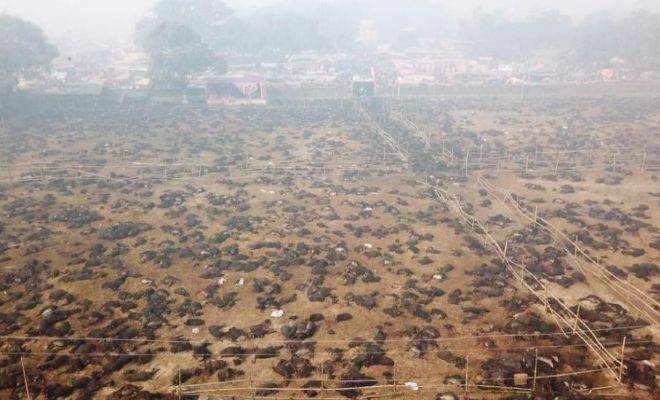- Biodiversity: A bonfire against poaching in Nepal
Like many of the Hindu legends, it also begins with a dream in which a bloodthirsty god appears, anxious for one of those sacrifices that are repeated in all religions but with different names and faces. In this case, it all started 265 years ago in a Nepalese town called Bariyarpur, near the border with India.
Bhagwan Chowdhary, a captive monk in prison, the powerful goddess Gadhimai appeared to him in dreams and told him that he would release him and bring him prosperity. In return, he would have to build a temple in his honor and make a human sacrifice. Bhagwan fulfilled the first requirement and founded the Gadhimai Temple.
Regarding the second condition, the monk made a small variation, and instead of humans sacrificed animals in gratitude. A tradition that was passed from generation to generation, celebrated every five years, attracting more and more devotees eager to satiate the goddess with blood. And Tuesday was the day when, once again, the biggest ritual slaughter of animals in the world began.
Animalist groups have been wanting to stop for years. Even the authorities of the neighboring country, of India, banned in the previous edition of this massacre disguised as a festival the sending of animals to their Nepalese neighbor. Although the merchants that carry the animals continue to cross the border without a license. And thousands of people have once again concentrated on Bariyarpur despite the fact that the Supreme Court of Nepal ordered the Government to discourage this bloodshed.
It is estimated that more than 300,000 animals will be slaughtered with a khukuri, a sharp sword popular in Nepal. There are buffaloes, goats, chickens, pigs, ducks ... even rats and pigeons . Anyone is worthy of having his neck cut with a single clean cut before the figure of the goddess Gadhimai.
About 200 butchers have already entered the sandy and walled enclosure, larger than a soccer field. And they have already begun to run rivers of blood in the presence of children climbed in trees to see and jelly a three-day massacre as a party that will bring them health and prosperity, and elders who will mix their blood with the spilled in the hope of lengthening their lifetime.
" What they do here is a brutal murder, " says Wendy Higgins, spokesman for the International Humanitarian Society (SHI) animalist association. "Animals are killed in front of each other, which will increase their distress, and this includes mothers killed in front of their babies," says Higgind.
The authorities of the Gadhimai Temple, in whose surroundings this massacre is celebrated, already banned the event four years ago. "Officials have let their personal beliefs rule over court orders. They did not do enough to discourage the killings," criticizes Manoj Gautam, a member of the Network for Animal Welfare who has been fighting for years to ban this celebration.
Organizations like Animal Equality launched a campaign weeks ago to try to stop the slaughter on December 3. Even the group demonstrated at Nepal's embassies in countries such as Spain, England or Mexico. But today the blood has run again in Bariyarpur.
According to the criteria of The Trust Project
Know more- Science and Health
- science
Astronomy A weekend to observe five planets
Climate crisis The concentration of greenhouse gases reaches a new record
Animals End to the enigma of parrots: they are not clumsy, they throw food on purpose to improve their quality and quantity

